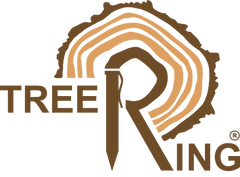ENVIROPRENEUR ON TREE RING PEN
Q: What are “Tree Ring Pens” and where does the wood supply come from?
A: Tree Ring Pens are fine writing instruments crafted from dated tree ring cores. Each pen includes the full chronology (first through last annual ring) of a tree’s life. Through these annual growth rings, each pen shows 100+ years of natural history. As children we learned we could figure out how old a tree was by counting its rings. To foresters and scientists tree rings serve as an encyclopedia of past forest and climate conditions, providing information on tree growth rates, climate patterns, forest fire history, and many other ecological topics. The Tree Ring Pen was created to share this unique resource through a commonly-used object. The wood for Tree Ring Pens comes from forest restoration projects in western Montana—specifically projects that aim to restore old growth forests.
Q: How did you come up with the idea for the Tree Ring Pen and how does it relate to forest restoration?
A: My idea for the Tree Ring Pen was born more than a decade ago while conducting dendrochronology (tree ring) research as part of my master’s degree. People seemed fascinated by the information and history imbedded in tree ring cores, and I had been thinking of ways to share tree rings in a wood product. One evening, while working in a dendrochronology lab, it dawned on me that tree rings could be displayed in a wooden pen. The idea for Tree Ring Pens sat on a back burner until I discovered an opportunity to wed it with the need to thin overstocked forests in the western U.S. As a result of nearly 100 years of fire suppression, some forests, including rare old growth stands, are unnaturally dense, and are more susceptible to fires and insect/disease mortality. Without restoration treatments, old-growth forests in dry regions of the West are at considerable risk. Removing the encroaching conifers through forest thinning is needed to restore and help protect remaining old growth forests.
Q: Does the purchase of a Tree Ring Pen contribute to future forest restoration projects?

A: Tree Ring Pens are crafted out of small understory trees that are adding unnatural stress to old growth trees. Thinning out the small diameter trees improves the resiliency of the old growth stands. The aim is to direct Tree Ring Pen restoration efforts at small patches of old growth that are being ignored because they lack the economies of scale that make restoration thinning economically viable. A significant portion of the remnant old growth forests are in remote locations, steep terrain, and/or small isolated patches. Remnant old growth stands exist today, in part, because they were too inaccessible or too steep to be logged economically when widespread logging of old growth forests occurred. Ironically, the same cost challenges that explain their existence also serve as an impediment to their conservation. By crafting a fine product that displays tree ring history, the low value of the small diameter trees can be greatly enhanced to provide the necessary economic incentive to accomplish restoration. Additionally, Tree Ring Pens LLC is donating 5 percent of the purchase price of the sale of each pen to organizations working on forest conservation and restoration.
Q: How do Tree Ring Pens connect their users with the history of the forest and the land?
A: The annual growth rings featured in each pen illustrate the events that shaped an individual tree, a forest, and the American West. For example, narrow rings formed during a 1930s drought illustrate the Dust Bowl. Each pen comes with a card displaying natural history events that impacted the growth of the tree and can be seen in its rings. Part of the allure of the pen is holding 100+ years of history in your hand and feeling a connection to a tree that lived through the last century.
Q: Looking ahead, what are your plans for the future of your business and enviropreneurship?
A: The global market for fine pens is estimated at $1 billion per year. Tree Ring Pens aims to capture enough market share to be able to facilitate meaningful restoration. I’m also expanding the tree ring concept to other products such as clocks, jewelry, and knives. My goal is to garner brand recognition for Tree Ring products that reflects the precious stories of history and restoration of majestic forests imbedded in each pen. In the spirit of dreaming big, I would like Tree Ring products to compete in the luxury good market with other goods made of preciously valued metals and gems.
Q: What did you take away from PERC’s Enviropreneur Institute that will help you develop your business and how will you incorporate market principles to enhance the environment?
A: I learned a number of practical lessons including business planning approaches, pricing models for licensing arrangements, and marketing techniques and strategies. Most importantly, I left the Enviropreneur Institute with a renewed “can do” spirit that permeates PERC’s staff, fellows, and alumni. This network from PERC is an invaluable resource that I’m truly grateful to have access to.


Leave a comment